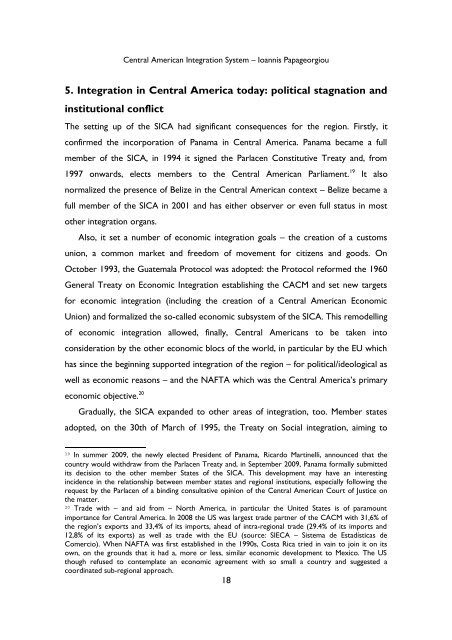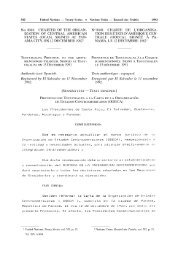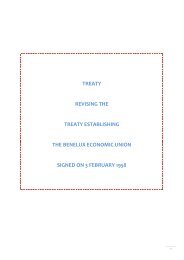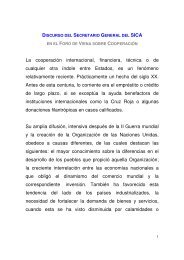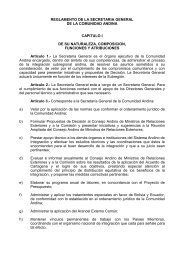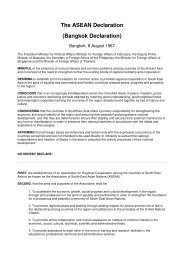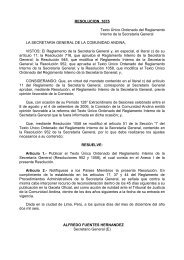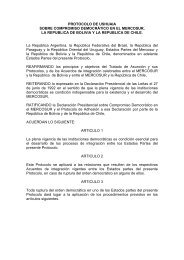Central American Integration System â Ioannis Papageorgiou
Central American Integration System â Ioannis Papageorgiou
Central American Integration System â Ioannis Papageorgiou
You also want an ePaper? Increase the reach of your titles
YUMPU automatically turns print PDFs into web optimized ePapers that Google loves.
<strong>Central</strong> <strong>American</strong> <strong>Integration</strong> <strong>System</strong> – <strong>Ioannis</strong> <strong>Papageorgiou</strong><br />
5. <strong>Integration</strong> in <strong>Central</strong> America today: political stagnation and<br />
institutional conflict<br />
The setting up of the SICA had significant consequences for the region. Firstly, it<br />
confirmed the incorporation of Panama in <strong>Central</strong> America. Panama became a full<br />
member of the SICA, in 1994 it signed the Parlacen Constitutive Treaty and, from<br />
1997 onwards, elects members to the <strong>Central</strong> <strong>American</strong> Parliament. 19 It also<br />
normalized the presence of Belize in the <strong>Central</strong> <strong>American</strong> context – Belize became a<br />
full member of the SICA in 2001 and has either observer or even full status in most<br />
other integration organs.<br />
Also, it set a number of economic integration goals – the creation of a customs<br />
union, a common market and freedom of movement for citizens and goods. On<br />
October 1993, the Guatemala Protocol was adopted: the Protocol reformed the 1960<br />
General Treaty on Economic <strong>Integration</strong> establishing the CACM and set new targets<br />
for economic integration (including the creation of a <strong>Central</strong> <strong>American</strong> Economic<br />
Union) and formalized the so-called economic subsystem of the SICA. This remodelling<br />
of economic integration allowed, finally, <strong>Central</strong> <strong>American</strong>s to be taken into<br />
consideration by the other economic blocs of the world, in particular by the EU which<br />
has since the beginning supported integration of the region – for political/ideological as<br />
well as economic reasons – and the NAFTA which was the <strong>Central</strong> America’s primary<br />
economic objective. 20<br />
Gradually, the SICA expanded to other areas of integration, too. Member states<br />
adopted, on the 30th of March of 1995, the Treaty on Social integration, aiming to<br />
19<br />
In summer 2009, the newly elected President of Panama, Ricardo Martinelli, announced that the<br />
country would withdraw from the Parlacen Treaty and, in September 2009, Panama formally submitted<br />
its decision to the other member States of the SICA. This development may have an interesting<br />
incidence in the relationship between member states and regional institutions, especially following the<br />
request by the Parlacen of a binding consultative opinion of the <strong>Central</strong> <strong>American</strong> Court of Justice on<br />
the matter.<br />
20<br />
Trade with – and aid from – North America, in particular the United States is of paramount<br />
importance for <strong>Central</strong> America. In 2008 the US was largest trade partner of the CACM with 31,6% of<br />
the region’s exports and 33,4% of its imports, ahead of intra-regional trade (29.4% of its imports and<br />
12,8% of its exports) as well as trade with the EU (source: SIECA – Sistema de Estadísticas de<br />
Comercio). When NAFTA was first established in the 1990s, Costa Rica tried in vain to join it on its<br />
own, on the grounds that it had a, more or less, similar economic development to Mexico. The US<br />
though refused to contemplate an economic agreement with so small a country and suggested a<br />
coordinated sub-regional approach.<br />
18


